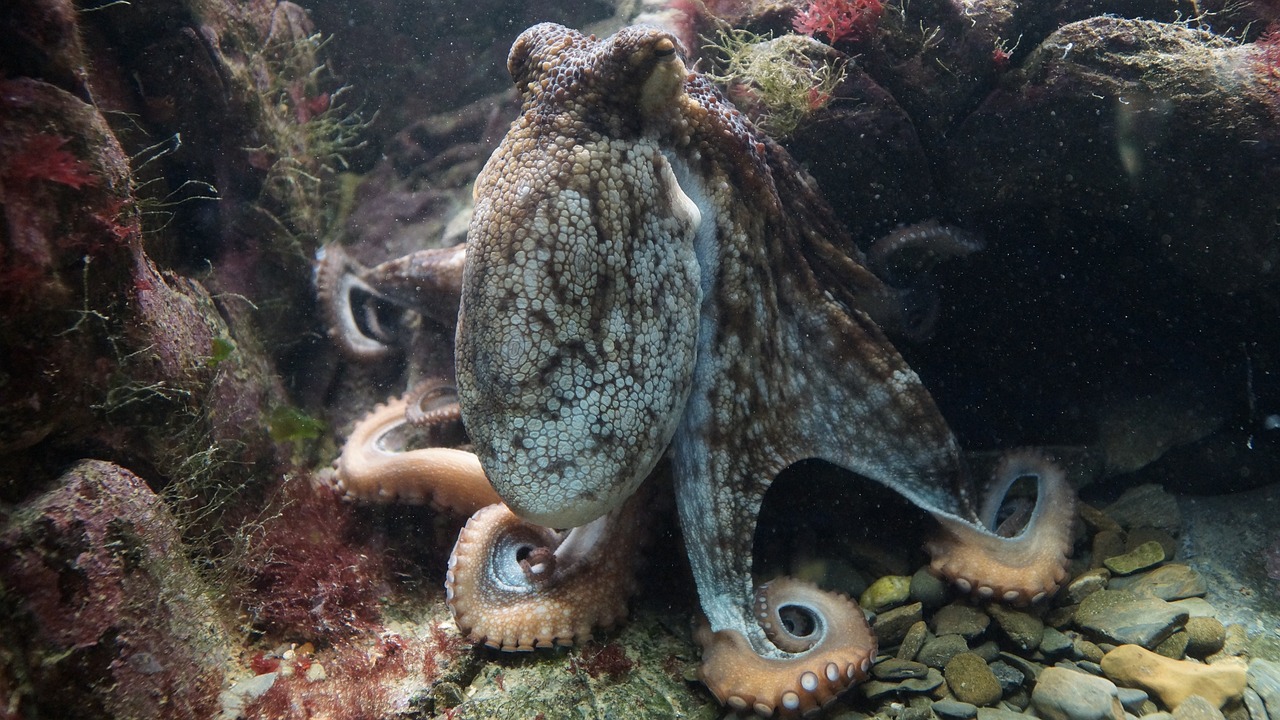Octopuses are fascinating underwater creatures known for their remarkable anatomy, intelligence, and adaptability. Their soft, flexible mantle houses vital organs, while their muscular system allows them to manipulate objects and capture prey. The octopus’s eight arms, equipped with hundreds of suction cups, serve multiple functions, including sensory perception and capturing prey. Their semi-autonomous nature allows them to operate independently, making complex movements and solving puzzles crucial to their survival.
The mystery of octopus beaks is their sharp, beak-like mouthparts for predation, which play a vital role in hunting and feeding strategies. Octopuses have three hearts for optimal blood flow, ensuring efficient circulation and oxygen transport throughout their body. They also possess remarkable regeneration powers, such as the ability to grow back lost limbs.
Octopuses communicate through chemical signals and use their intelligence to solve complex puzzles and navigate mazes. They face threats from various predators, including sharks, large fish, and certain marine mammals, using defense mechanisms like camouflage and jet propulsion. They also employ venomous bites for defense and subduing prey.
However, octopuses face numerous threats, including pollution and overfishing, which affect their populations. As we continue to explore the mysteries of octopus biology, we gain a greater appreciation for the complexity and beauty of the underwater world.
Octopus tentacles are multifunctional tools used by marine creatures for various activities, including capturing prey and manipulating objects. Each octopus typically has eight tentacles, each with its own neural cluster, known as a “mini-brain,” which allows them to perform complex actions independently without constant oversight from the central brain. The tentacles also possess an extraordinary level of tactile sensitivity, allowing them to detect even the slightest changes in texture, temperature, and pressure.
Octopus tentacles are a testament to their adaptability and sophistication, with their unique structure and ability to regenerate when lost. Their intelligence is crucial in their ability to navigate the ocean, providing them with a wide array of cognitive tools to thrive in a dynamic environment. Octopuses are skilled at solving intricate puzzles, making them virtually invisible to predators and prey alike. They are also adept at mimicking other marine animals, such as lionfish, sea snakes, or flounders, to avoid potential threats and aid in predatory pursuits. They also navigate through complex ocean currents, analyzing their direction and speed to adapt their movements accordingly.
Octopus intelligence is an essential asset in their mastery of ocean navigation, as their cognitive toolbox includes problem-solving skills, memory, sensory perception, and spatial awareness. The art of camouflage and mimicry further enhances their navigational strategies, allowing them to adapt seamlessly to diverse oceanic environments. As we continue to unravel the depths of octopus intelligence, we gain a deeper appreciation for their role as navigational maestros of the ocean, a testament to nature’s remarkable ingenuity.
Octopuses, with their remarkable regenerative abilities and relatively short lifespan, are fascinating creatures in the underwater world. They have the remarkable ability to regenerate lost body parts, such as tentacles, through specialized cells called “blastemal cells.” This self-repair mechanism enhances their chances of survival and resilience in the face of adversity. However, their lifespan is relatively short due to their semelparous reproductive strategy, senescence, and environmental threats.
Octopuses also possess remarkable camouflage abilities, allowing them to blend seamlessly into their surroundings and evade predators and prey. Their camouflage skills include changing skin color and texture with astonishing speed and precision through chromatophores, color matching, and creating intricate patterns on their skin. Their rapid adaptation is a testament to their cognitive abilities and neural control over their chromatophores.
The camouflage abilities of octopuses are intricately linked to their intelligence. Their advanced brains allow them to perceive their surroundings, analyze threats, and adapt their camouflage strategies accordingly. They can assess the colors, textures, and movements of their environment and make rapid decisions to remain hidden or launch a surprise attack.
Octopus-inspired robotics is indeed a rapidly advancing field with a wide range of potential applications across various industries. These robots, drawing inspiration from the remarkable abilities of octopuses, offer unique advantages in terms of flexibility, dexterity, and adaptability. Here are some additional details and examples:
Soft Robotics: Soft robots, like the Octobot, are highly maneuverable and adaptable to complex environments. They can be used for minimally invasive surgery, where their softness reduces the risk of tissue damage, as well as disaster relief efforts, where they can navigate through debris to locate survivors.
Underwater Robotics: Octopus-inspired robots excel in underwater exploration due to their agility and ability to navigate tight spaces. They are ideal for tasks such as studying marine ecosystems, inspecting underwater infrastructure, and conducting search and rescue missions in oceans and lakes.
Assistive Robotics: The dexterity and gentle touch of octopus-inspired robotic arms make them valuable tools for assisting people with disabilities. These robots can be used to perform tasks like helping individuals with mobility impairments with daily activities, and enhancing their independence and quality of life.
Manufacturing: In manufacturing, octopus-inspired robots can improve precision and efficiency in tasks that require delicate manipulation, such as assembling small electronic components or handling fragile materials. Their flexibility allows them to adapt to different production line needs.
Healthcare: Octopus-inspired robots hold potential in the healthcare sector for applications like minimally invasive surgeries, where their soft and flexible nature can reduce the invasiveness of procedures, leading to quicker recovery times and fewer complications.
Space Exploration: Octopus-inspired robots may find applications in space exploration missions, where their adaptability and resilience can be valuable for tasks like repairing or maintaining equipment in the harsh conditions of space.
The examples you provided, such as the Octobot, Octopus Gripper, and Octopus Arm, highlight the diversity of designs and applications within this field. Researchers and engineers continue to push the boundaries of what is possible with octopus-inspired robotics, paving the way for innovative solutions to complex challenges in various industries.
In conclusion, octopuses’ remarkable camouflage abilities and intelligence are a testament to the wonders of evolution and adaptation in the underwater world.

